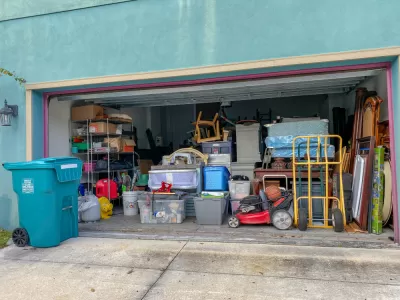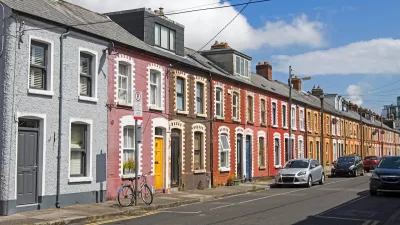With curbside parking available for free in front of most American homes, residents with private garages often choose to utilize the space for household storage. Putting a price on street parking could change that.

“The government constructs, maintains and distributes free car storage space along the curb in front of almost every house,” asserts Catie Gould, and because of this readily available parking space in single-family neighborhoods, many Americans park their cars on the street and use their garages for other purposes.
“A survey of detached homeowners in Sacramento, California, published in February, showed that when there isn’t space enough for both storing a car and household items, the cars are the items that end up moving elsewhere. The survey found that 37 percent of homeowners didn’t store a single car in their garage.” Surveys from other cities show similar results. A long-range UCLA study “found that 3 of 4 households had too much stuff in their garage to park a car.”
According to Gould, “When storing a car on the curb is free, a garage isn’t necessarily a garage: it’s a great big walk-in closet.” So, Gould asks, “When there is so much evidence that people don’t reliably use private parking spaces to store their cars, why does nearly every city still require them to be built?” Gould explains that these requirements can have a negative impact on housing affordability. “Mandates for off-street parking spaces raise housing costs and prevent housing from being built in the first place.”
Using an example from Vancouver, British Columbia, Gould argues that cities should price curb spaces to incentivize residents to park in their own garages or driveways and free up curbside space for public parking or other uses.
FULL STORY: One in Three Garages Has No Car in It

Americans May Be Stuck — But Why?
Americans are moving a lot less than they once did, and that is a problem. While Yoni Applebaum, in his highly-publicized article Stuck, gets the reasons badly wrong, it's still important to ask: why are we moving so much less than before?

Using Old Oil and Gas Wells for Green Energy Storage
Penn State researchers have found that repurposing abandoned oil and gas wells for geothermal-assisted compressed-air energy storage can boost efficiency, reduce environmental risks, and support clean energy and job transitions.

Placekeeping: Setting a New Precedent for City Planners
How a preservation-based approach to redevelopment and urban design can prevent displacement and honor legacy communities.

San Francisco’s Muni Ridership Grew in 2024
The system saw its highest ridership since before the Covid-19 pandemic, but faces a severe budget shortage in the coming year.

Colorado Lawmakers Move to Protect BRT Funding
In the face of potential federal funding cuts, CDOT leaders reasserted their commitment to planned bus rapid transit projects.

Safe Streets Funding in Jeopardy
The Trump administration is specifically targeting bike infrastructure and other road safety projects in its funding cuts.
Urban Design for Planners 1: Software Tools
This six-course series explores essential urban design concepts using open source software and equips planners with the tools they need to participate fully in the urban design process.
Planning for Universal Design
Learn the tools for implementing Universal Design in planning regulations.
Heyer Gruel & Associates PA
City of Moreno Valley
Institute for Housing and Urban Development Studies (IHS)
City of Grandview
Harvard GSD Executive Education
Salt Lake City
NYU Wagner Graduate School of Public Service
City of Cambridge, Maryland





























